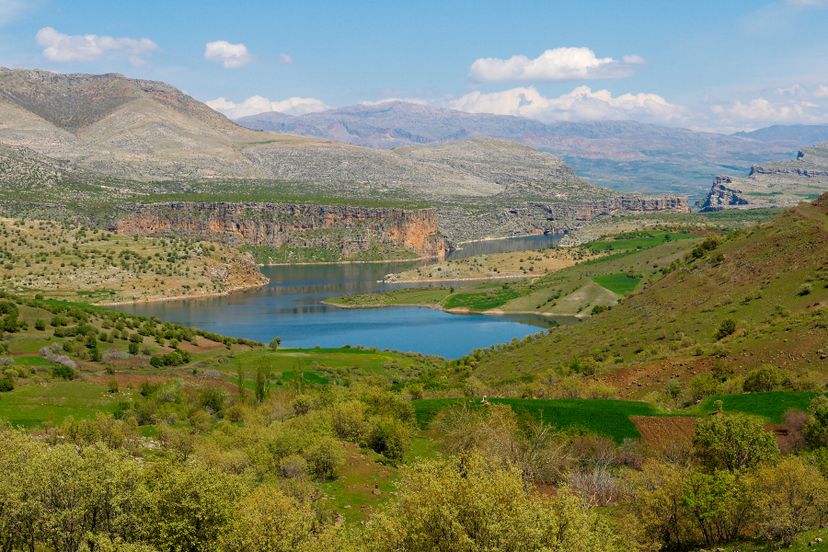
About This Quiz
The area once known as the cradle of civilization gave birth to the wheel, writing, irrigation and even the 60-second minute. Take the quiz and see what you know about the ancient civilizations of Mesopotamia.The ancient region known as Mesopotamia was in the eastern Mediterranean flanked in the northeast by the Zagros mountains and in the southeast by the Arabian plateau. It corresponds closely to today's Iraq, but also parts of modern-day Iran, Syria and Turkey.
Excavations indicate humans lived and settled in Mesopotamia as far back as 10,000 B.C.E., settling in the land, domesticating animals and perfecting the agriculture.
Mesopotamia actually means "two rivers" and refers to the Tigris and the Euphrates rivers.
Advertisement
Mesopotamia was known as the cradle of civilization.
Intellect was very important, and the schools, which were primarily for the priestly class, were said to be numerous.
They believed they were co-workers with the gods, and the land was full of spirits.
Advertisement
The Sumerians created the earliest civilization in Mesopotamia around 3000 B.C.E.
Ancient Mesopotamia was basically an agrarian society, so the principal jobs were maintaining farmland and crops.
Women were the original brewers of beer and wine, as well as the healers in the community, but these trades were eventually later taken over by men, when it became obvious they were lucrative.
Advertisement
Sumer was the southernmost region of ancient Mesopotamia.
The Sumerians were the first to create the city as we know it and to establish writing.
Mesopotamia was situated between the Tigris and Euphrates rivers, which regularly flooded, depositing rich soil ideal for farming.
Advertisement
Men actually hold most power in Sumeria, but women do have power in their families.
Ziggurats -- tiered, pyramid-like temples -- were built to honor the gods and goddesses.
In cuneiform, Sumerians used a writing implement known as a stylus to press into soft clay to produce wedge-like impressions that represented word-signs.
Advertisement
The Akkadians took power of Mesopotamia around 2350 B.C.E.
Sargon the Great, founder of the Akkadian Empire, conquered all of Mesopotamia and created the first multinational empire in history.
The ancient city of Babylon is one of the most famous cities of the ancient world and today can be found near the town of Al-Hillah in modern-day Iraq.
Advertisement
Hammurabi was the sixth king in the Babylonian dynasty, which ruled in central Mesopotamia (present-day Iraq) from 1894 to 1595 B.C.E.
Although it's often cited as the oldest, it's predated by at least two others from the Middle East: one created by the Sumerian ruler Ur-Nammu of the city of Ur, which dates back to the 21st century B.C.E., and the Sumerian Code of Lipit-Ishtar of Isin, which was written nearly 200 years before Hammurabi came to power.
Hammurabi's Code places the burden of proof on the accuser.
Advertisement
The Hittites, Kassites and Assyrians all ruled Babylon between 1595 and 681 B.C.E.
Nebuchadnezzar II is said to have ruled while the Hanging Gardens of Babylon and famous Ishtar Gate were built.
The Euphrates River was located on the western side of Mesopotamia. The Tigris was located on the eastern side.
Advertisement
The empire fell to the Persians under Cyrus the Great, effectively ending Babylonian culture.
After Cyrus defeated Babylon, most of Mesopotamia fell under the Persian Empire, and this period saw a rapid cultural decline.
The Persian Empire fell to Alexander the Great in 331 B.C.E.
Advertisement
Mesopotamia was largely Hellenized and lacked any signs of the old gods and ways of Mesopotamia.
The entire culture of Mesopotamia was dealt its final blow when Muslim Arabs overtook the area in the 7th century C.E., which resulted in the Islamic law, language, religion and culture.
The wheel, writing, astronomy, mathematics, wind power, irrigation, agricultural and even the 60-second minute can all be attributed to the land of Mesopotamia.
Advertisement